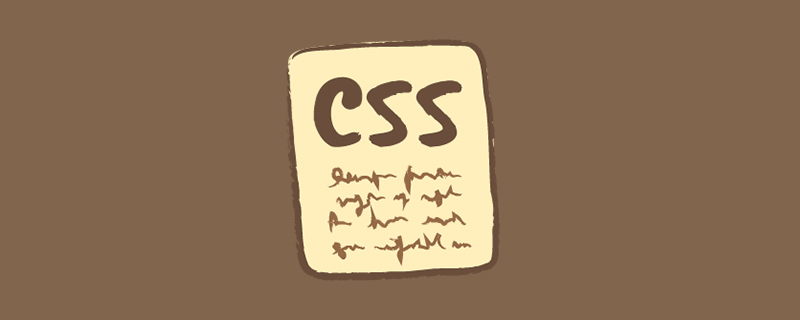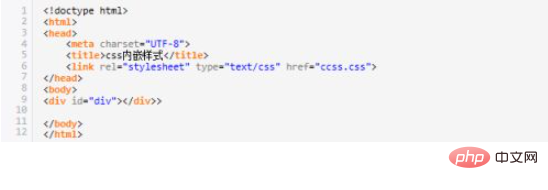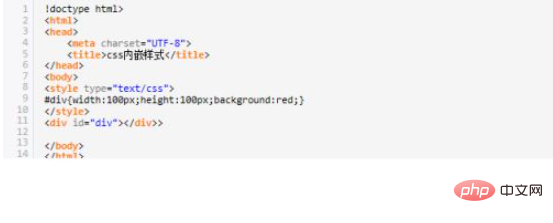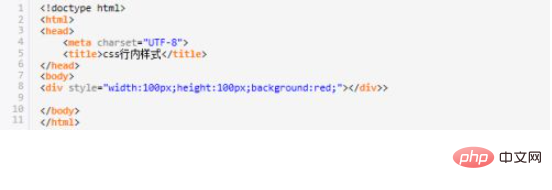What are the usages of css?
css usage: 1. When you want to apply the same style consistently on all or part of the web pages on the site, you can use an external style sheet; 2. When people just want to define the style of the current web page, you can use the embedded Style sheet; 3. Inline style is to directly add CSS code to HTML tags.

The operating environment of this tutorial: windows7 system, css3 version, DELL G3 computer.
css usage:
1. External formula:
(1) Usage: When you want to display all or Use an external style sheet when you apply the same style consistently across parts of a web page. Defining styles in one or more external style sheets and linking them to all web pages ensures a consistent look across all web pages. If people decide to change the style, they only need to modify it once in the external style sheet, and the change will be reflected on all pages linked to the style sheet.
(2) Example: Usually external style sheets have .css as the file extension, such as Mystyles.css. Then link it in the pages that require this style.

2. Embedded:
(1) Usage: When people just want to define the style of the current web page, they can use Embedded stylesheet. An embedded style sheet is a cascading style sheet that is "embedded" within the tag of a web page. Styles in embedded style sheets can only be used on the same web page.
(2) Example: In Microsoft FrontPage2000, some formatting features are automatically applied as inline styles. For example: If you use the Borders & Shadows command (on the Format menu) to apply a box around an ordinary paragraph, FrontPage writes the formatting information as inline style properties for the paragraph mark.

3. Inline style:
Inline style is to directly add CSS code to HTML tags, that is, as HTML tags attribute tag exists. In this way, you can easily define styles for an element individually.

Related learning recommendations: css tutorial
The above is the detailed content of What are the usages of css?. For more information, please follow other related articles on the PHP Chinese website!

Hot AI Tools

Undresser.AI Undress
AI-powered app for creating realistic nude photos

AI Clothes Remover
Online AI tool for removing clothes from photos.

Undress AI Tool
Undress images for free

Clothoff.io
AI clothes remover

Video Face Swap
Swap faces in any video effortlessly with our completely free AI face swap tool!

Hot Article

Hot Tools

Notepad++7.3.1
Easy-to-use and free code editor

SublimeText3 Chinese version
Chinese version, very easy to use

Zend Studio 13.0.1
Powerful PHP integrated development environment

Dreamweaver CS6
Visual web development tools

SublimeText3 Mac version
God-level code editing software (SublimeText3)

Hot Topics
 Vue 3
Apr 02, 2025 pm 06:32 PM
Vue 3
Apr 02, 2025 pm 06:32 PM
It's out! Congrats to the Vue team for getting it done, I know it was a massive effort and a long time coming. All new docs, as well.
 Can you get valid CSS property values from the browser?
Apr 02, 2025 pm 06:17 PM
Can you get valid CSS property values from the browser?
Apr 02, 2025 pm 06:17 PM
I had someone write in with this very legit question. Lea just blogged about how you can get valid CSS properties themselves from the browser. That's like this.
 A bit on ci/cd
Apr 02, 2025 pm 06:21 PM
A bit on ci/cd
Apr 02, 2025 pm 06:21 PM
I'd say "website" fits better than "mobile app" but I like this framing from Max Lynch:
 Stacked Cards with Sticky Positioning and a Dash of Sass
Apr 03, 2025 am 10:30 AM
Stacked Cards with Sticky Positioning and a Dash of Sass
Apr 03, 2025 am 10:30 AM
The other day, I spotted this particularly lovely bit from Corey Ginnivan’s website where a collection of cards stack on top of one another as you scroll.
 Using Markdown and Localization in the WordPress Block Editor
Apr 02, 2025 am 04:27 AM
Using Markdown and Localization in the WordPress Block Editor
Apr 02, 2025 am 04:27 AM
If we need to show documentation to the user directly in the WordPress editor, what is the best way to do it?
 Comparing Browsers for Responsive Design
Apr 02, 2025 pm 06:25 PM
Comparing Browsers for Responsive Design
Apr 02, 2025 pm 06:25 PM
There are a number of these desktop apps where the goal is showing your site at different dimensions all at the same time. So you can, for example, be writing
 How to Use CSS Grid for Sticky Headers and Footers
Apr 02, 2025 pm 06:29 PM
How to Use CSS Grid for Sticky Headers and Footers
Apr 02, 2025 pm 06:29 PM
CSS Grid is a collection of properties designed to make layout easier than it’s ever been. Like anything, there's a bit of a learning curve, but Grid is
 Why are the purple slashed areas in the Flex layout mistakenly considered 'overflow space'?
Apr 05, 2025 pm 05:51 PM
Why are the purple slashed areas in the Flex layout mistakenly considered 'overflow space'?
Apr 05, 2025 pm 05:51 PM
Questions about purple slash areas in Flex layouts When using Flex layouts, you may encounter some confusing phenomena, such as in the developer tools (d...






